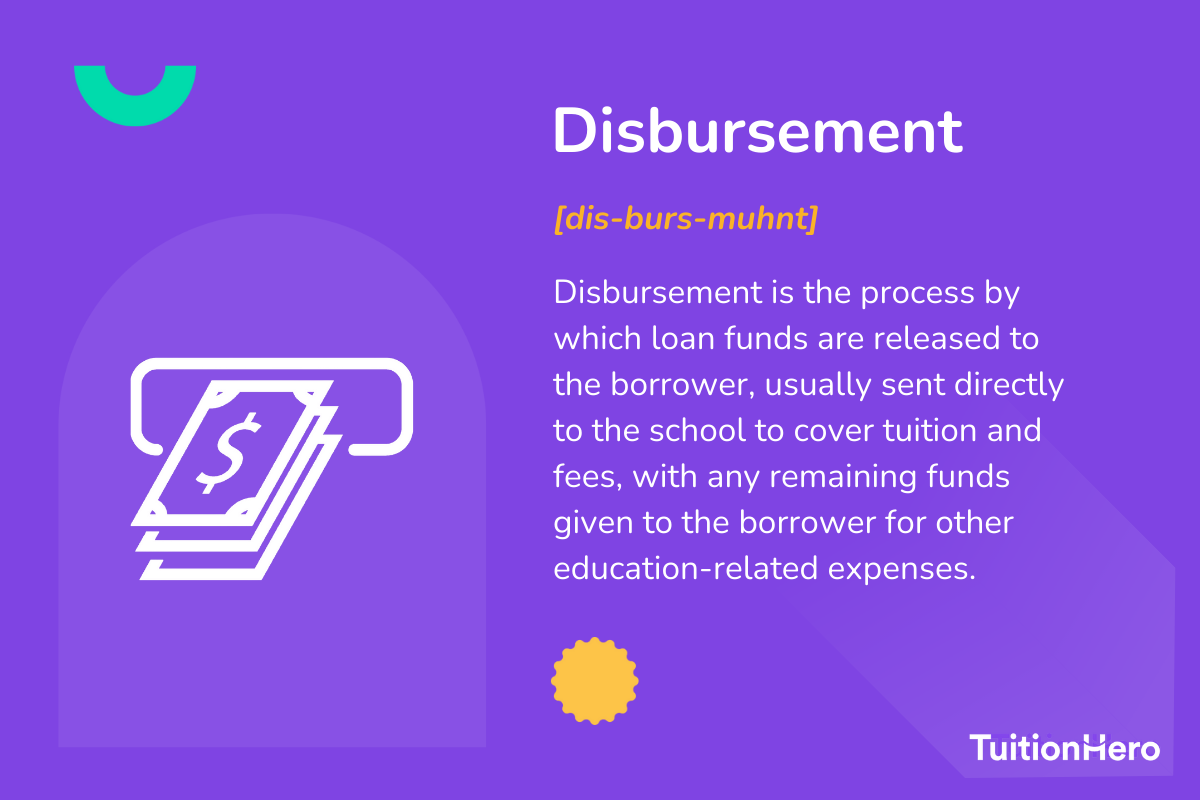Advertiser Disclosure
Last update: November 17, 2024
4 minutes read
What Is a Disbursement in Student Loans?
Confused about student loan disbursements? Learn how they work, their types, and how to manage them effectively.

By Brian Flaherty, B.A. Economics
Edited by Rachel Lauren, B.A. in Business and Political Economy
Learn more about our editorial standards



By Brian Flaherty, B.A. Economics
Edited by Rachel Lauren, B.A. in Business and Political Economy
Learn more about our editorial standards
In college finance, it's essential to know the difference between words like disbursement and payment, and it's important to be clear about what they mean. This post will help you understand what a disbursement is in student loans and how it impacts your finances while you're in school. Discover how optimizing your loan strategies can benefit you when refinancing student loans.

Key takeaways
- Student loan disbursements are payouts of loan funds for covering educational expenses
- Understanding the difference between disbursement and drawdown can help in financial planning
- Practice the dos and don'ts to ensure responsible management of disbursed funds
What is a disbursement in student loans?
A disbursement in student loans is the process where loan funds are paid out to cover your educational expenses. It's an exciting moment because it means your financial aid plan is in action, supporting your college journey.
It's essential to know that a disbursement isn’t a one-time event. Federal and private student loans usually release funds in multiple installments throughout the academic year.

This strategy ensures the funds are used as intended - primarily for tuition and fees initially, followed by other educational expenses. Here’s an example breakdown of disbursement timing and purpose:
- First disbursement: Applied directly to tuition and school fees.
- Subsequent disbursements: Cover books, supplies, and living expenses.
This process centers around the school's financial aid office. They work with lenders to make sure the money is given out correctly.
After the initial costs are covered, any remaining amount is refunded to the student. This refund can support living expenses or buy essential academic materials.

TuitionHero Tip
It's important to keep an eye on each payment and how it affects the total amount you owe. Even though it might seem good to get extra money, remember that it adds to what you have to pay back later.
Disbursement vs. Drawdown
Understanding the subtle differences between disbursement and drawdown can significantly affect how you manage your education funds.
What is a disbursement?
A disbursement is when the money from a loan is given to your school or to you. It's like a transaction where the loan amount goes from the lender to you, mostly for educational costs. A typical example includes federal and private student loans being disbursed at the start of the semester.
What is a drawdown?
A drawdown happens when you take some money out of a larger amount. This term is often used with credit lines or retirement savings, but it also applies when you get money from your student loan.
For example, if you take out $10,000 from a $100,000 loan, it means you've received $10,000, and there's now $10,000 less in your total available funds, leaving you with a remaining $90,000.
Types of disbursement
Not all disbursements are created equal. The terms controlled and delayed disbursement come into play, affecting how funds flow and are used.
Controlled disbursement
This is a financial management tool that allows for the scheduling and release of funds in a careful way. Banks offer it as a service to their corporate clients, enabling them to manage cash flow efficiently by deciding the exact timing of disbursements.
Delayed disbursement
Also known as remote disbursement, this involves intentionally prolonging the payment process. Historically beneficial due to the lag in physical check processing, its use has decreased with the invention of electronic transfers.
Compare private student loans now
TuitionHero simplifies your student loan decision, with multiple top loans side-by-side.
Compare Rates
Dos and Don'ts of managing student loan disbursements
Understanding how student loan disbursements work is important. Knowing the right steps to take and the ones to avoid can help you manage your loans better, reducing financial stress while you're in college and after you graduate.
Do
Do review disbursement notifications carefully. Understand the amount and timing.
Do use disbursement funds strictly for educational expenses. This ensures the loan serves its intended purpose.
Do keep track of each disbursement and its effect on your loan balance. Awareness is key to managing debt effectively.
Don't
Don't ignore communication from your lender or school. Missing out on key details can lead to surprises.
Don't spend loan disbursements on non-educational items. Misuse of funds can lead to financial issues later.
Don't lose sight of your overall loan balance. It's easy to overlook the cumulative effect of each disbursement.

Why trust TuitionHero
How TuitionHero can help you
At TuitionHero, we help with managing your student loans efficiently and finding scholarships. Check us out to handle your student loans well and possibly reduce the need for more loans.we also offer comprehensive advice on scholarships and credit card offers tailored for students.
Frequently asked questions (FAQ)
Being smart about using your loan disbursement starts with a clear budget. Focus on essential expenses like tuition, books, and living costs.
Think ahead about the whole semester, and plan for unexpected costs. It's also wise to save some for emergencies.
If there's any left over after covering your educational needs, consider returning it to reduce your loan balance. For more on managing student loans, check out our student loan management resources.
Directly, loan disbursements don’t affect your credit score. However, how you use and repay your loans can have significant effects.
Using disbursements wisely and making timely repayments can positively influence your credit history. On the other hand, mishandling loan funds and accruing more debt than necessary, followed by late or missed payments, can hurt your credit score.
First, contact your school's financial aid office to understand the cause of the delay. It could be due to paperwork errors, processing delays, or verification issues.
Keeping open communication with your lender and the financial aid office is key. In the meantime, have a backup plan for covering immediate expenses, like using savings or a student-friendly credit card for urgent costs. At TuitionHero, we can help guide you through these challenges.
Final thoughts
It’s important to know how student loan payments work to handle your college finances efficiently. We've talked about what payments are, the contrast between payment and withdrawal, the different types of payments, and given advice on what to do and what to avoid. We also discussed the pros and cons of student loan payments.
Source
Author

Brian Flaherty
Brian is a graduate of the University of Virginia where he earned a B.A. in Economics. After graduation, Brian spent four years working at a wealth management firm advising high-net-worth investors and institutions. During his time there, he passed the rigorous Series 65 exam and rose to a high-level strategy position.
Editor

Rachel Lauren
Rachel Lauren is the co-founder and COO of Debbie, a tech startup that offers an app to help people pay off their credit card debt for good through rewards and behavioral psychology. She was previously a venture capital investor at BDMI, as well as an equity research analyst at Credit Suisse.
At TuitionHero, we're not just passionate about our work - we take immense pride in it. Our dedicated team of writers diligently follows strict editorial standards, ensuring that every piece of content we publish is accurate, current, and highly valuable. We don't just strive for quality; we aim for excellence.
Related posts
While you're at it, here are some other college finance-related blog posts you might be interested in.
Shop and compare student financing options - 100% free!

Always free, always fast
TuitionHero is 100% free to use. Here, you can instantly view and compare multiple top lenders side-by-side.

Won’t affect credit score
Don’t worry – checking your rates with TuitionHero never impacts your credit score!

Safe and secure
We take your information's security seriously. We apply industry best practices to ensure your data is safe.
Finished scrolling? Start saving & find your private student loan rate today





